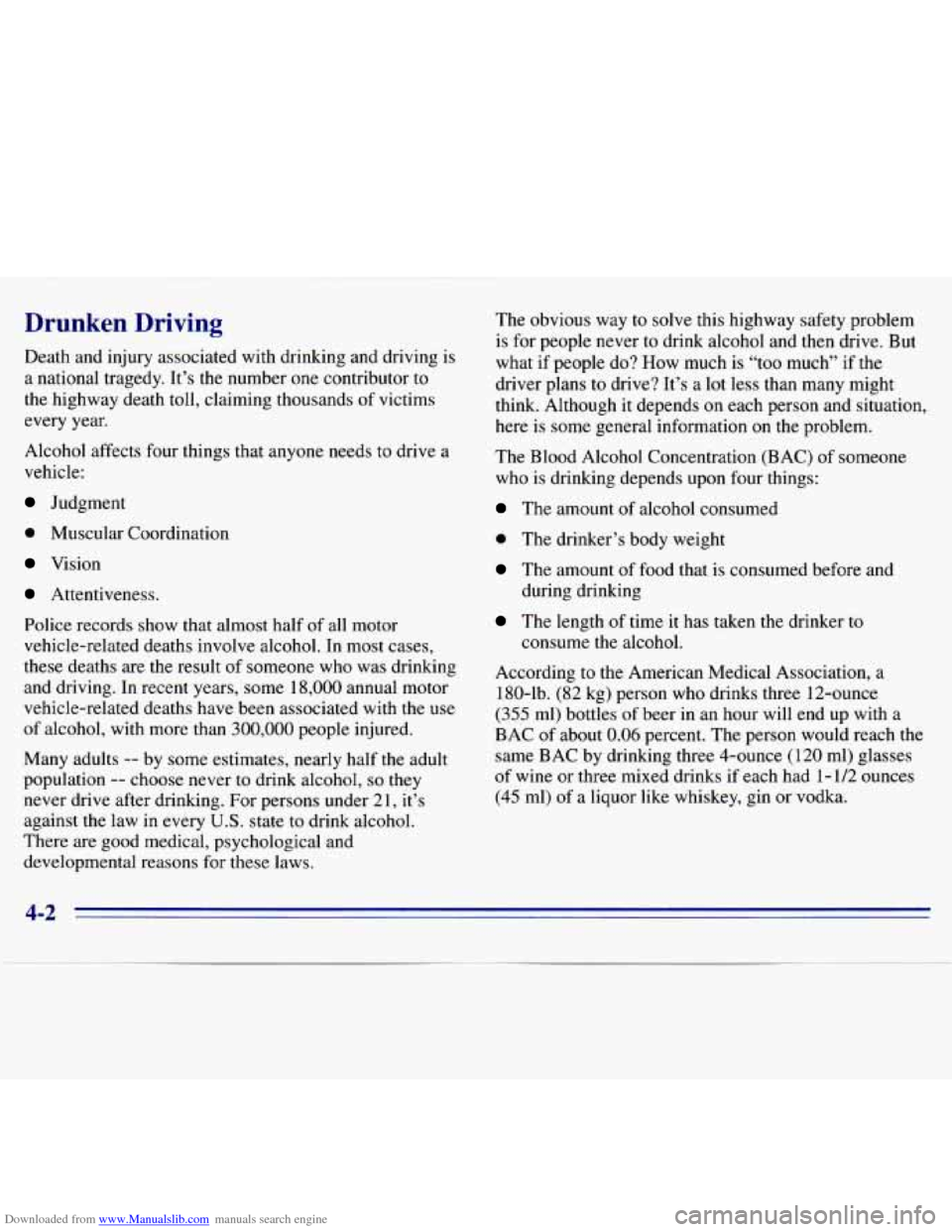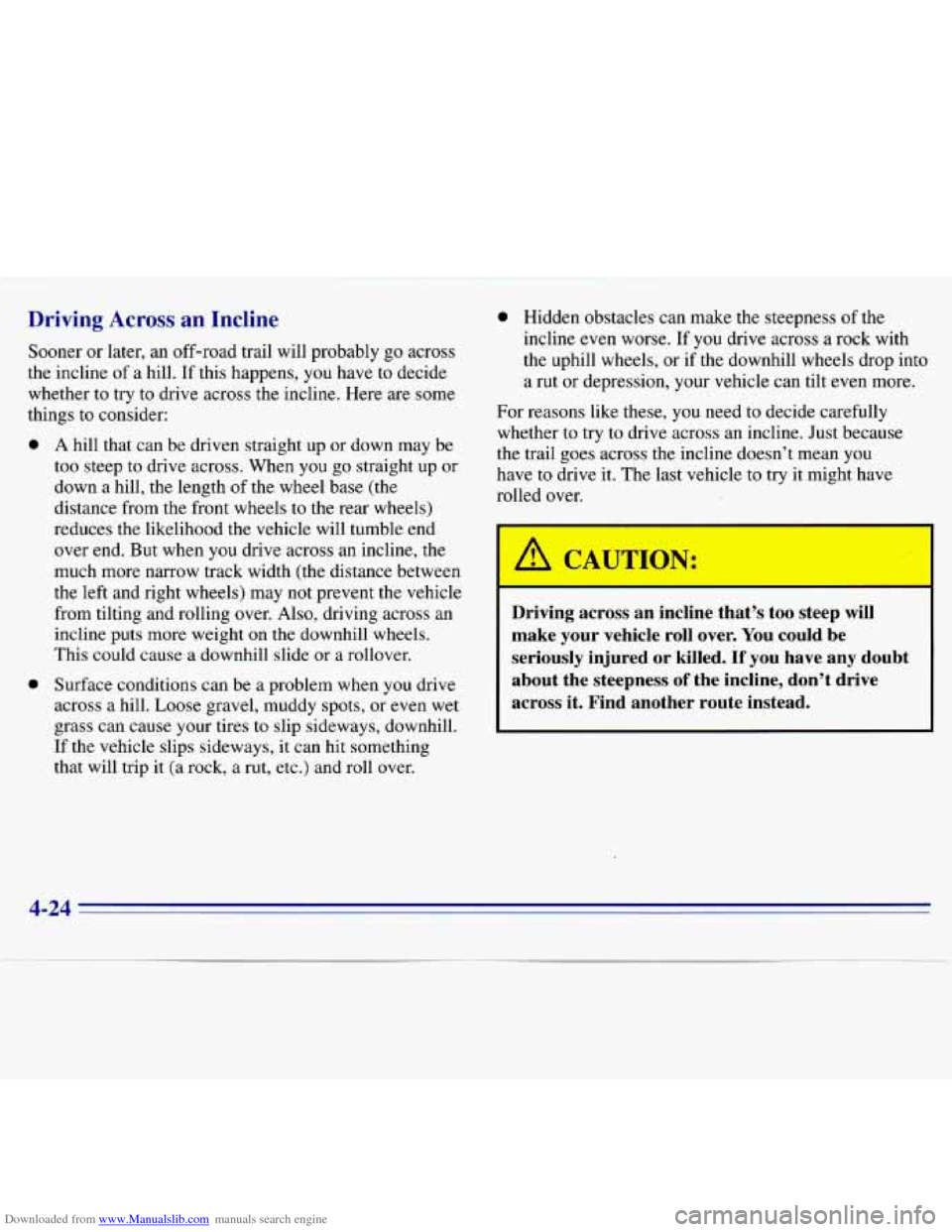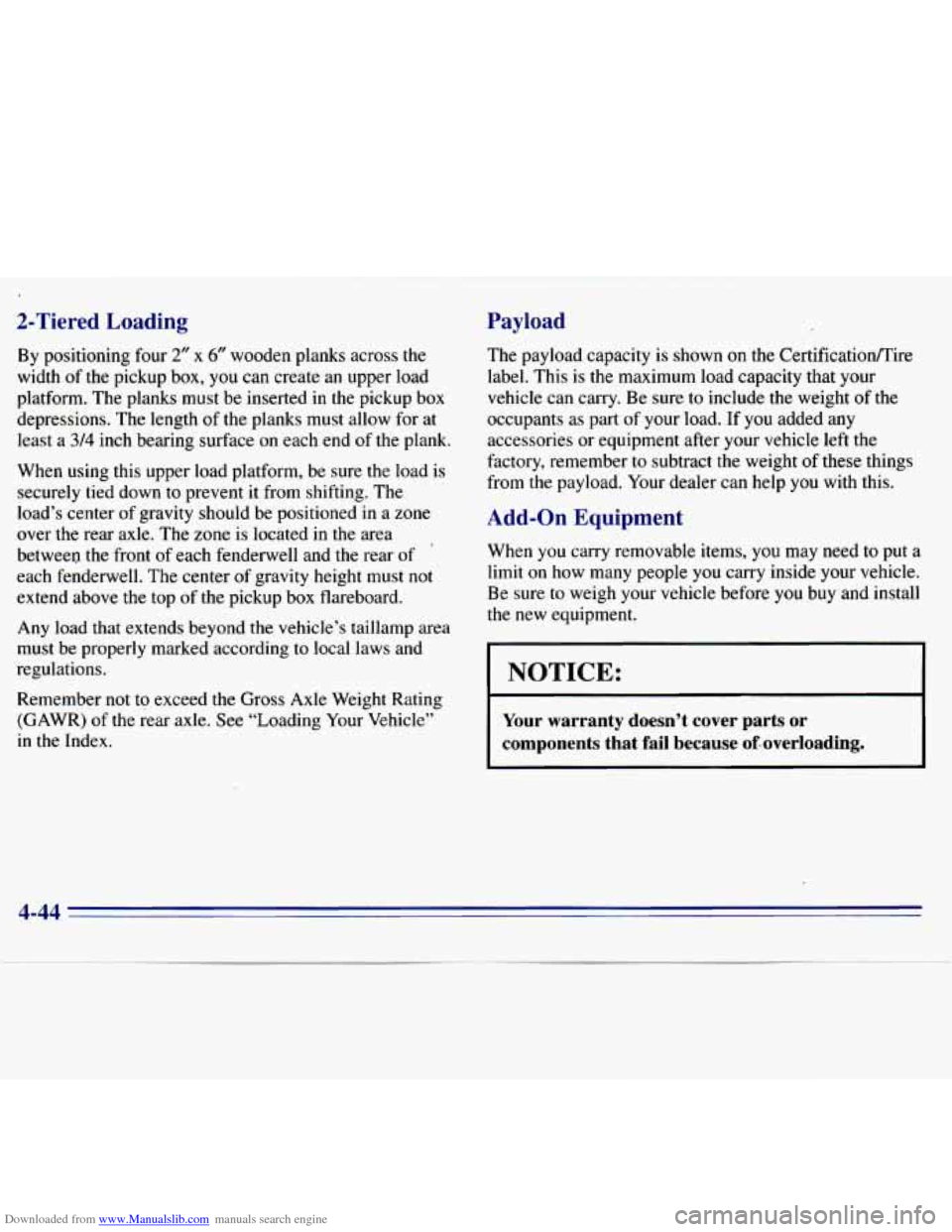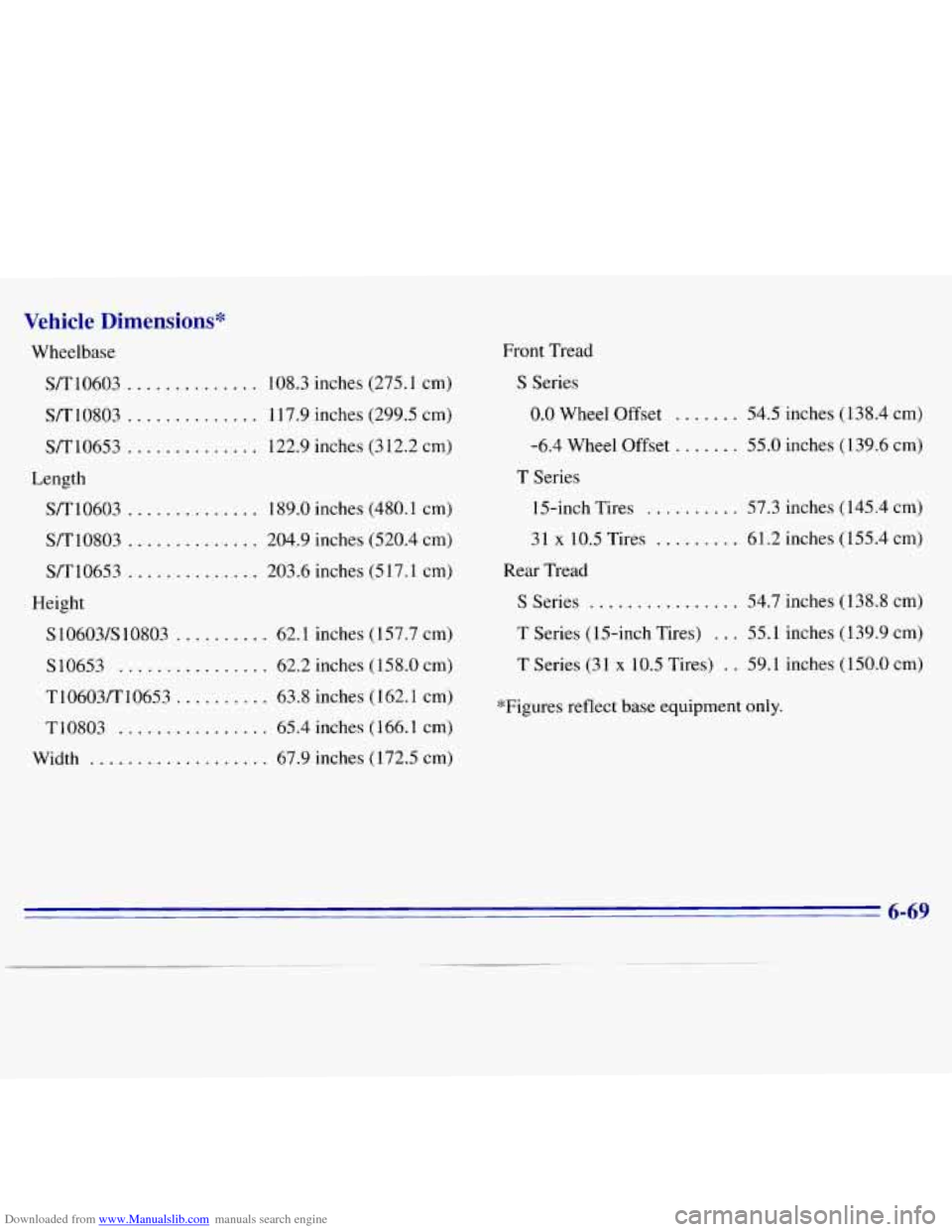length CHEVROLET S10 1996 2.G Owners Manual
[x] Cancel search | Manufacturer: CHEVROLET, Model Year: 1996, Model line: S10, Model: CHEVROLET S10 1996 2.GPages: 375, PDF Size: 20.73 MB
Page 133 of 375

Downloaded from www.Manualslib.com manuals search engine Drunken Driving
Death and injury associated with drinking and driving is
a national tragedy. It’s the number one contributor to
the highway death toll, claiming thousands of victims
every year.
Alcohol affects four things that anyone needs to drive
a
vehicle:
Judgment
0 Muscular Coordination
Vision
Attentiveness.
Police records show that almost half
of all motor
vehicle-related deaths involve alcohol. In most cases,
these deaths are
the result of someone who was drinking
and driving. In recent years, some 18,000 annual motor
vehicle-related deaths have been associated with the
use
of alcohol, with more than 300,000 people injured.
Many adults
-- by some estimates, nearly half the adult
population
-- choose never to drink alcohol, so they
never drive after drinking. For persons under 2
1, it’s
against the law in every U.S. state
to drink alcohol.
There are good medical, psychological and
developmental reasons for these laws. The
obvious way
to solve this highway safety problem
is for people never
to drink alcohol and then drive. But
what if people do? How much
is “too much” if the
driver plans to drive? It’s a lot less than many might
think. Although it depends on each person and situation,
here is some general information
on the problem.
The Blood Alcohol Concentration (BAC)
of someone
who is drinking depends upon four things:
The amount of alcohol consumed
0 The drinker’s body weight
The amount of food that is consumed before and
during drinking
The length of time it has taken the drinker to
consume the alcohol.
According to the American Medical Association, a
180-lb. (82 kg) person who drinks three 12-ounce
(355 ml) bottles of beer in an hour will end up with a
BAC of about
0.06 percent. The person would reach the
same BAC by drinking three 4-ounce (120 ml) glasses
of wine or three mixed drinks if each had 1-1/2 ounces
(45 ml)
of a liquor like whiskey, gin or vodka.
Page 155 of 375

Downloaded from www.Manualslib.com manuals search engine Driving Across an Incline
Sooner or later, an off-road trail will probably go across
the incline of a hill.
If this happens, you have to decide
whether to try to drive across the incline. Here are some
things to consider:
0
8
A hill that can be driven straight up or down may be
too steep to drive across. When you
go straight up or
down a hill, the length of the wheel base (the
distance from the front wheels to the rear wheels)
reduces the likelihood the vehicle will tumble end
over end. But when you drive across
an incline, the
much more narrow track width (the distance between
the left and right wheels) may not prevent the vehicle from tilting and rolling over. Also, driving across an
incline puts more weight on
the downhill wheels.
This could cause a downhill slide or a rollover.
Surface conditions can be a problem when you drive
across a hill. Loose gravel, muddy spots,
or even wet
grass can cause your tires to slip sideways, downhill.
If the vehicle slips sideways, it can hit something
that will trip it (a rock, a rut, etc.) and roll over.
0 Hidden obstacles can make the steepness of the
incline even worse. If you drive across a rock with
the uphill wheels, or if the downhill wheels drop into
a rut or depression, your vehicle can tilt even more.
For reasons like these, you need to decide carefully
whether
to try to drive across an incline. Just because
the trail goes across the incline doesn’t mean
you
have to drive it. The last vehicle to try it might have
rolled over.
‘ A CAUTIC 7:
,1
Driving across an incline that’s too steep will
make your vehicle roll over. You could be
seriously injured or killed.
If you have any doubt
about the steepness of the incline, don’t drive
across it. Find another route instead.
A 3A
Page 175 of 375

Downloaded from www.Manualslib.com manuals search engine 2-Tiered Loading
By positioning four 2” x 6” wooden planks across the
width of the pickup box, you can create an upper load
platform. The planks
must be inserted in the pickup box
depressions. The length of the planks must allow for at
least a
314 inch bearing surface on each end of the plank.
When using this upper load platform, be sure the load is
securely tied down to prevent
it from shifting. The
load’s center
of gravity should be positioned in a zone
over the rear axle. The zone is located
in the area
between the front
of each fenderwell and the rear of
each fenderwell. The center of gravity height must not
extend above
the top of the pickup box flareboard.
Any load that extends beyond the vehicle’s taillamp area
must be properly marked according to local laws and
regulations.
Remember not to exceed the Gross Axle Weight Rating
(GAWR) of the rear axle. See “Loading Your Vehicle”
in the Index.
Payload
The payload capacity is shown on the Certification/Tire
label. This is the maximum load capacity that your
vehicle can carry. Be sure to include the weight of the
occupants as part of your load. If you added any
accessories or equipment after your vehicle left the
factory, remember
to subtract the weight of these things
from the payload. Your dealer can help you with this.
Add-on Equipment
When you carry removable items, you may need to put a
limit on how many people you carry inside your vehicle.
Be sure to weigh your vehicle before you buy and install
the new equipment.
NOTICE:
I
Your warranty doesn’t cover parts or
components that fail because of, overloading.
4-44
~ .~ .
Page 295 of 375

Downloaded from www.Manualslib.com manuals search engine Vehicle Dimensions"
Wheelbase S/T10603
.............. 108.3 inches (275.1 cm)
S/T10803
.............. 117.9 inches (299.5 cm)
S/T10653
.............. 122.9 inches (312.2 cm)
Length
S/T 10603 .............. I 89.0 inches (480.1 cm)
S/T10803
.............. 204.9 inches (520.4 cm)
S/T10653
.............. 203.6 inches (517.1 cm)
Height
S10603/S10803
.......... 62.1 inches (157.7 cm)
SI0653
................ 62.2 inches (158.0 cm)
T10603/T10653..
........ 63.8 inches (162.1 cm)
T10803
................ 65.4 inches (166.1 cm)
Width
................... 67.9 inches (172.5 cm) Front
Tread
S Series
0.0 Wheel Offset ....... 54.5 inches (138.4 cm)
-6.4 Wheel Offset
....... 55.0 inches (139.6 cm)
T Series
15-inch Tires
.......... 57.3 inches (145.4 cm)
3 1
x 10.5 Tires ......... 61.2 inches (155.4 cm)
Rear Tread
S Series ................ 54.7 inches ( 138.8 cm)
T Series (15-inch Tires)
... 55.1 inches (139.9 cm)
T Series (3 1
x 10.5 Tires) . . 59.1 inches (150.0 cm)
*Figures reflect
base equipment only.
6-69